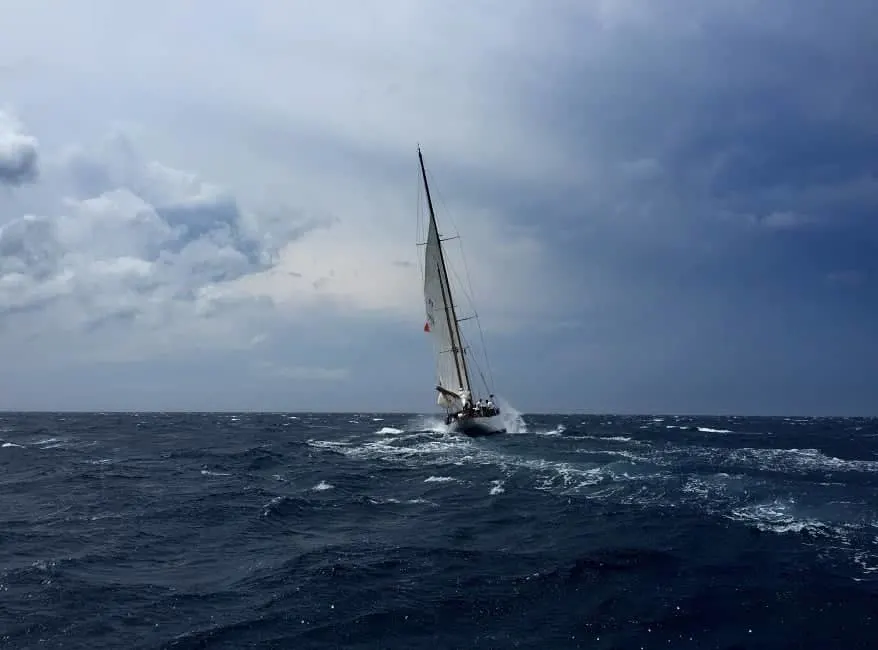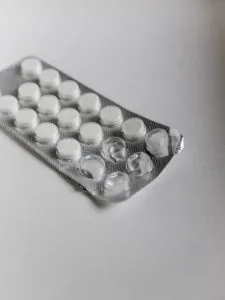We’re very excited to share this guest post on seasickness by John Neal of Mahina Expeditions. We’re huge fans on John and Amanda who spend seven months every years at sea (logging approx. 10,000 miles annually). They’ve authored over seven books on ocean cruising and contributed to many others. John has sailed 342,000 miles, rounding Cape Horn six times, and as such knows a thing or two about seasickness! In this guest post he provides invaluable advice on seasickness avoidance and treatment.

When day sailing, seasickness goes away once land is reached or the anchor is down. However, on coastal or offshore passages longer than 24 hours preventing or effectively treating seasickness becomes a health and safety issue as left untreated, continual seasickness results in incapacitatation.
Some level of queasiness or seasickness is normal and should be expected during the first 1-4 days of an ocean passage, even if you have never been seasick while coastal sailing. Seasickness is caused by sensory conflict and/or stress, both of which result in histamine production. Nausea results when histamine reaches the brain. Some people are more susceptible than others but given the right conditions anyone can become seasick. Having dealt with over 400 seasick sailors over the past 42 years at sea, we have become very experienced at prevention and treatment. If you want to avoid seasickness or recover quickly, follow these steps.
The responsibility for the safety of the vessel doesn’t go away if you’re seasick. A continual watch for hazards, other vessels, navigation and weather monitoring must be maintained. It is essential to maintain your full watches no matter how you feel; lying in your bunk is not an option. Helping others get over seasickness as quickly as possible must be the focus and responsibility of all on board. Frequently seasick crew will ask to be left alone, saying they don’t feel like drinking or eating. Leaving them alone is a mistake as it is imperative to keep them sipping fluids and regularly eating small amounts.
To avoid or lessen the severity of seasickness the following steps should be taken:
Prior to sailing
- Avoid coffee, black tea, colas and alcohol (all of which are diuretics), fatty and histamine-producing foods including tuna, tomatoes, salami, hard cheeses and sauerkraut at least 2 – 4 days before the passage.
- Increase your water intake to 2 to 3 liters per day.
- Give each crew member their own 1-liter water bottle labeled with their name.
- Start appropriate seasickness medication at least 24 hours prior to departure: 2-3 grams of Vitamin C, Berocca, Stugeron tablets, Compazine suppositories or TransDerm Scopolamine patches.
- Prepare everything possible before departure to minimize time required below decks once underway: have meals planned and ready, bunks made up and lee cloths rigged, navigation organized and appropriate clothes laid out.

Once Underway
Whether or not you feel any symptoms of seasickness, it is essential to:
- Maintain a steady fluid intake of one liter per 2-3-hour watch ensuring a total of 2-3 liters per day.
- As soon as seasick symptoms appear (mild headache, queasiness, sweating, drowsiness, depression) sensory conflict has caused histamine production to start and a more disciplined response is required.
- Add Emer’gen-C (available from Amazon and in health food stores), Berocca or a similar electrolyte replacement vitamin-mineral drink mix to your drink bottle. The electrolyte replacement helps your cells absorb fluid more quickly and completely. Gatorade and similar sports drinks lack Vitamin C which counteracts histamine production.
- Eat small amounts of food on a regular basis: crackers, cookies, crystallized ginger, canned fruit or hard candies. Bananas provide potassium and are an excellent first choice if available. A new option is Anchor Nutrition motion sickness bars.
Effective seasickness medication

- Stugeron (cinnarizine) 15 mg tablets are unavailable in the US, but are readily available in many countries including the UK or from www.CanadaDrugsOnline.com. Stugeron, an over-the-counter antihistamine has consistently proven to be one the most effective anti-seasick medication causing less drowsiness than other antihistamines, however, Stugeron Forte 75 mg tablets are unnecessarily strong and should be avoided.
- Compazine (prochlorperazine) 5, 10 or 25 mg suppositories (not oral) have proven to be the most effective prescription anti-nausea and anti-anxiety medication that does not cause drowsiness. As anxiety can cause nausea and since Compazine treats both it is an important drug to carry aboard. Suppositories are far more effective than tablets once vomiting has started.
- Transderm Scopolamine 1.5 mg patches may work when no other drug does, but one MUST first test this drug out on land as documented side effects include drowsiness, blurred vision, disorientation, anxiety, hallucinations and psychosis. Expect major personality changes and serious drowsiness if this Scopolamine is used more than four days.
CAUTION! With any drug, prescription or over the counter, there are published side effects. Do your homework; ask your physician and pharmacist and research each drug. If you have heart, blood pressure or prostate problems your physician may not be able to prescribe some of these drugs. Test each anti-seasickness drug ashore well before departure to check for side effects.
Feeling queasy? If so:
- Take the helm and steer the boat, focusing on the horizon. If the boat is overpowered, reduce sail. If you are sailing close-hauled, ease sheets and fall off.
- When going below, first take your foulies off in the cockpit rather than below decks. Minimize time working below if possible. The faster you either get back on deck or lie down the better you’ll feel. Lying down prevents histamine from reaching the brain, decreasing nausea.
- Avoid lying down in your foulies for an extended period of time to lessen the chance of hyperthermia.
- Maintain medications and review whether additional or different medications are required.

Going to Vomit? If so:
- Vomit into a 2-liter plastic container with tight-fitting lid that you can use on deck and below.
- To avoid a possible overboard situation do not lean over the lifelines to vomit; use a container.
- Most people feel considerably better after vomiting, but it is essential to maintain a steady fluid-electrolyte intake. Take small sips, stay hydrated, and keep your blood sugar level up. This is helpful for avoiding Sopite syndrome which will make you feel like sleeping and not wanting to eat or drink. Giving into Sopite puts you at risk of prolonged dehydration, which can lead to shock.
- Prolonged vomiting causes dehydration surprisingly quickly, hypothermia (even in the tropics) anxiety, confusion, depression and shock. Once in shock, an enema or IV is the next step to rehydration and your survival.
After departure, coastal wave refraction and associated choppiness should be followed by more regular ocean swells, so do not be initially discouraged by seasickness. In almost all cases sailors recover from seasickness within 1-4 days if they follow the above advice.
Inherent in accepting and mastering these steps is realizing your responsibility and doing everything within your power to get over or help crew mates get over seasickness as quickly as possible. No one wants to be a liability aboard. In most cases, those that have come through appreciate that managing seasickness effectively is a key to unlocking the pleasures of blue water sailing.
John Neal

Kristin
Monday 16th of December 2019
Thanks for this super interesting post! I only saw the Stugeron Regular on CanadaDrugsOnline in 25m, not 15mg like the article stated. Is that the right one? I see the 75mg one which I'll avoid. Thanks!